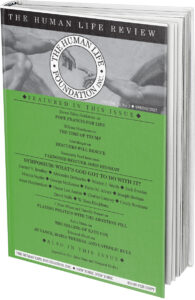DEFINING DEATH, NOT DEFINING LIFE
The February 5, 2014 issue of the New England Journal of Medicine (NEJM) features an opinion piece by two bioethicists and a medical doctor vigorously defending a “brain death” definition of death against individual dissenters—such as the McMath family in California—in the name of ensuring “bright lines” on how society determines when someone is no longer part of society (http://www.nejm.org/doi/full/10.1056/NEJMp1400930.) What is less bright about this editorial are the philosophical axes being ground in the background.
The authors—David C. Magnus, PhD, Benjamin S. Wilfond, MD., and Arthur L. Caplan, PhD—profess concern about the cases of two women: Marliese Muñoz in Texas, whose family wanted her taken off life support when the hospital (at first) wanted to keep her on it, and Jahi McMath in California, whose family insisted she be kept on life support when the hospital wanted to remove it (a court has since ruled that her family could transfer young Jahi to another facility, one willing to maintain her body on a ventilator, which they have done).
Without getting into the ethics of the McMath case, I want to focus on the NEJM article’s highly selective presentation of the Muñoz case.
Magnus, Wilfond, and Caplan admit that Muñoz was pregnant. They note she was “14 weeks pregnant when she died from pulmonary embolism” and that the Texas hospital initially refused to disconnect her from the respirator because of a “state law requiring that support not be terminated if a patient is pregnant.” They also acknowledge that “a pregnancy can be maintained even after the pregnant woman has met the neurologic criteria for death.”
Unfortunately, the authors end their discussion without addressing a most relevant question: In the Muñoz case, were there one patient, or two? It is relevant because when there are two patients, basic medical ethics requires taking cognizance of the interests of both, starting with the elementary axiom, primum non nocere (first, do no harm). An honest ethical discussion must address that question; it must at least acknowledge that there is an argument to be made that life begins at conception, in which case the fate of her child would be a separate question from that of Marlise Muñoz herself. The authors cannot pretend that the question does not exist simply because they do not want to speak to it.
If human life begins at conception, then it is at least theoretically possible that the unborn child—as a patient—can have real medical interests independent of her mother. That contrast becomes even sharper if the child’s mother is declared to be dead. As modern bioethicists do not fail to remind us, it is possible to maintain the appearance of life even in a dead body, even though that appearance is of no practical benefit to the deceased. But if the body is a corpse receiving no benefit, neither is it being injured. On the other hand, the lack of benefit to the dead mother does not address the question of whether the medical procedure is of benefit to the unborn child.
Professors Caplan and Magnus are honorable men, noted in the bioethics field. But honorable men ought not to get away with evading the question by claiming that “[w]hen a person is dead, life support has to end regardless of what parents, judges or legislators might want to believe . . . .” Such sophistry tries to decide questions of life and death by ignoring them, with the real-life consequences affecting other’s lives.
Without coming out and saying it in so many words, the NEJM article leaves the impression that, once Marlise Muñoz was declared dead, there was nothing else to be said. Not only does it ignore the fact that turning off the ventilator killed her unborn child, it maintains an insidious front of silence that refuses even to consider the possibility that another patient’s interests could have been at stake.
What is true of the end of life ought to be true of its beginning. Indeed, it should be more true of its beginnings, because a humane society is not one eager to usher members out, one foot on the edge of the grave and another on a banana peel. For all the pooh-poohing about slippery-slope arguments, there is something fundamentally awry with a society that demands clarity as to when one ceases to be its member, but is willing to fudge all manner of ambiguity about when one joins. Such a society has embraced what Bl. John Paul properly called “a culture of death.”
The determination of life is, as the authors say, a “highly significant social boundary.” Yet, for more than four decades, the United States has feigned agnosticism about being able accurately (and officially) to demarcate its beginning. A “wink, wink, nudge, nudge” approach to unspoken assumptions about where that boundary lies has made it possible for butchers like Kermit Gosnell to kill while the law looks the other way. (Gosnell was finally brought to justice only because a police investigation into his illegal drug business revealed the horrors taking place at his abortion clinic.) But I hold no illusion that the team of Magnus, Wilfond, and Caplan is going to call for “bright lines” at the beginning of life which might actually correspond with the biological “facts of life.”
* * * * *
—John M. Grondelski (Ph.D., Fordham) was associate dean of the School of Theology, Seton Hall University, South Orange, NJ (USA).
For more about Jahi McMath, see this piece by Wesley J. Smith:









